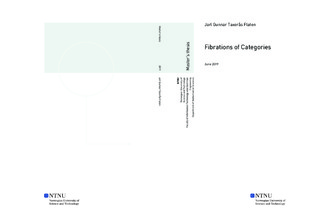Fibrasjoner av Kategorier
Master thesis
Permanent lenke
http://hdl.handle.net/11250/2622851Utgivelsesdato
2019Metadata
Vis full innførselSamlinger
Sammendrag
Det finnes en {\em kanonisk} modellstruktur på $\Cat$ som bruker ekvivalenser av kategorier, og vi forsøker å forstå fibrasjonene involvert. Første kapittel gir en detaljert utledning av at yonedaimbeddingen $\y : \C \to \Set_\C$ er en {\em fri kokomplettering} av kategorien $\C$. Ut av dette springer et paradigme av ``nerve og realisering''-adjunksjoner, som generaliserer en rekke klassiske konstruksjoner. I kapittel 2 motiveres først {\em diskrete fibrasjoner} via topologiske overdekningsrom, og disse fibrasjonene klassifiseres som funktorer $\C \to \Set$. Dette er intimt knyttet til den frie kokompletteringen og ulike linjer trekkes. Deretter går vi detaljert gjennom konstruksjonen av nevnt kanoniske modellstruktur. Til slutt gis en versjon av Quillen sitt {\em ``small object argument''} for {\em presenterbare} kategorier. There is a {\em canonical} model structure on $\Cat$ whose weak equivalences are the categorical ones, and we attempt to develop an intrinsic understanding of the fibrations involved. In Chapter 1 we work out the category theory required to prove that the Yoneda embedding $\y : \C \to \Set_\C$ is the {\em free cocompletion} of $\C$. This gives rise to a paradigm of ``nerve-realization'' adjunctions which subsume various classical constructions. Chapter 2 motivates {\em discrete fibrations} of categories through topological covering spaces, and the relation to Chapter 1 is made explicit by classifying discrete fibrations $\cat{E} \fib \C$ as functors $\C \to \Set$. Observing this in the context of the free cocompletion proves fruitful. Finally, we explicitely construct the canonical model structure on $\Cat$ and we prove its uniqueness with respect to the set of weak equivalences. We conclude with an account of Quillen's {\em small object argument} for {\em presentable} categories.
